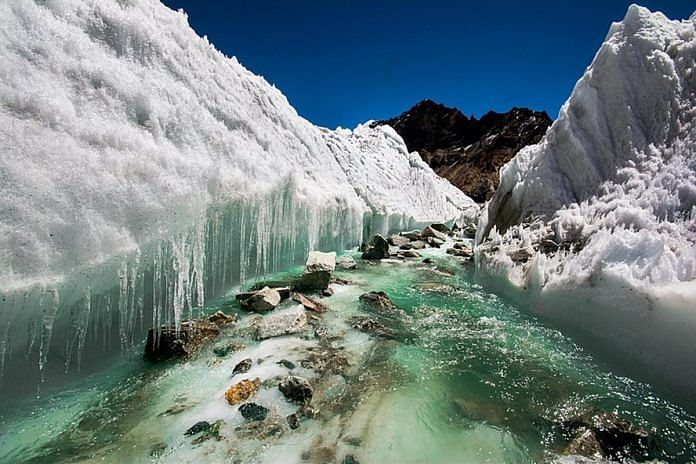New Delhi: Glaciers in the Indian Himalayas are not monitored as widely as they should be, a report tabled in Parliament has warned, recommending that the government set up an apex body to coordinate research efforts across departments on glacier melt.
The Parliamentary Standing Committee on Water Resources tabled its 23rd report on glacier management and monitoring Wednesday, calling for an “urgent, coherent and coordinated response to the evolving challenges posed by global warming and climate change”.
The Himalayan-Karakoram region is warming at a faster rate compared to the global mean average, making the case of monitoring glaciers “vital and critically important as never before”, the panel said.
The committee had been set up in 2020-2021, but the report could not be finalised till now.
Nearly a dozen organisations are already conducting research on glaciers and the river systems attached to them, the panel noted, but added that there was a need to have an overarching body in charge of coordinating research, because “fragmented research…will not yield desired results”.
The committee has tasked the Department of Water Resources, River Development & Ganga Rejuvenation with setting up such an institution for glacier management, with instructions to revert on progress by June.
The need stems from the fact that glaciers are a significant source of water security in India, the panel said. According to its report, there are as many as 9775 glaciers in the Indian Himalayan Region, and “a total of 1306.1 cubic km of ice volume is locked up in glacierised basins of Indus, Ganga and Brahmaputra”.
Also Read: Melting glaciers, water scarcity, exodus: How climate change reality is biting Ladakh villages
‘Meagre’ funds for glacier management
The committee reviewed submissions and sought information from over a dozen organisations before coming to its conclusions, including the Ministry of Environment, the Department of Science and Technology, and research institutes like the Wadia Institute of Himalayan Geology.
The panel noted that despite several government agencies working in the Himalayas, there was no data available on the volume of glacier loss from 1950 to 2020, nor were there any projections for glacier loss till 2100.
Data was also missing on the “enlargement and origin of glacial lakes near human settlements”, and no specific information could be found on areas most likely to be affected by glacial lake outburst floods.
The committee called the funds allocated for glacier management and monitoring “meagre”, and urged the government to disburse adequate finance so that “activities related to research and monitoring of glaciers do not suffer due to shortage of funds”. The Indian Space Research Organisation (ISRO) and the Department of Science and Technology utilised Rs 27.61 crore in various projects over the years, from 2010 to 2025.
Significantly, the committee has also urged the government to form “data sharing agreements” with foreign countries in the region, since “glaciers transcend the national boundaries of the Himalayan nations”. Pakistan, Bangladesh and Nepal are all connected to the same river systems that supply India with water, namely the Indus, Ganges, and Brahmaputra rivers.
The panel also says bureaucratic hurdles to accessing high quality data should be minimised by keeping all related information in one place “to enable its easy access and sharing by researchers and other stakeholders”.
The Department of Water Resources and Ganga Rejuvenation, along with the Ministry of External Affairs, should “have some kind of bilateral/multilateral agreement with neighbouring Himalayan countries for sharing of information/data on the changing state of glaciers and the threats posed by them”.
‘Formulate construction regulations expeditiously’
Acting on the recommendation of the National Disaster Management Authority, the panel also suggested that the Department of Water Resources constitute a committee that can “formulate specific land use zoning and building construction regulations expeditiously”, particularly in places that are prone to landslides.
The recommendation comes months after accelerated land subsidence struck the town of Joshimath in Uttarakhand in December last year, rendering over 800 people homeless overnight. Experts have said poor urban planning and lack of sustainable development in a landslide prone area led to the disaster.
Other recommendations include scaling up early warning systems, strengthening the national disaster response force, and monitoring smaller glaciers and water bodies, since they are “vulnerable to climate change which accelerates their melting and thereby pose potent threat” to settlements nearby.
(Edited by Gitanjali Das)
Also Read: 15 million at risk of disastrous glacial lake outbursts, Indians among top 4, says study



